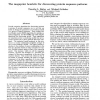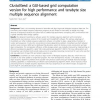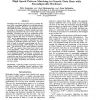64 search results - page 8 / 13 » Identification of weak motifs in multiple biological sequenc... |
ISMB
1996
13 years 8 months ago
1996
Several computeralgorithms for discovering patterns in groups of protein sequences are in use that are basedon fitting the parametersof a statistical model to a group of related s...
BMCBI
2010
13 years 7 months ago
2010
Background: There is an increasing demand to assemble and align large-scale biological sequence data sets. The commonly used multiple sequence alignment programs are still limited...
BMCBI
2006
13 years 7 months ago
2006
Background: The learning of global genetic regulatory networks from expression data is a severely under-constrained problem that is aided by reducing the dimensionality of the sea...
BMCBI
2004
13 years 7 months ago
2004
Background: In a previous paper, we introduced MUSCLE, a new program for creating multiple alignments of protein sequences, giving a brief summary of the algorithm and showing MUS...
ISMB
1994
13 years 8 months ago
1994
Homologydetection in large data bases is probably the most time consuming operation in molecular genetic computing systems. Moreover, the progresses made all around the world conc...



